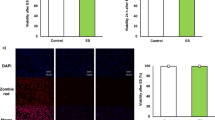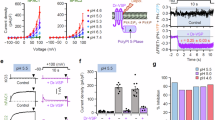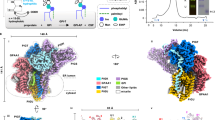Abstract
The term ’stimulus-secretion coupling‘ has, since first enunciated1, been held to involve the mobilization of cytosol Ca2+, which in turn is sufficient to trigger exocytotic secretory processes in metabolically competent cells. However, recent studies on a wide range of secretory cell types indicate that a role for Ca2+ can be obviated: examples are stimulation with phorbol ester (phorbol myristate acetate, PMA)2,3 which causes the activation of protein kinase C4 or the stimulation of platelets with collagen5. Ca2+-independent exocytosis also occurs when analogues of GTP are injected through the lumen of patch pipettes directly into the cytosol of mast cells6. The results presented here suggest that GTP analogues can activate secretory processes by actions at two distinct locations: one may be at the level of the receptor7 involving the activation of polyphos-phoinositide (PPI) phosphodiesterase8 with consequent liberation of diacylglycerol (DG)9; the other involves direct activation of the exocytotic mechanism. These conclusions are based on measurements of exocytotic secretion from permeabilized neutrophils into which we have been able to introduce, individually and in combination, Ca2+ chelators (EGTA and BAPTA), Ca2+ (buffered at micromolar concentrations with EGTA), analogues of GTP and GDP and the direct activator of protein kinase C, PMA.
This is a preview of subscription content, access via your institution
Access options
Subscribe to this journal
Receive 51 print issues and online access
$199.00 per year
only $3.90 per issue
Buy this article
- Purchase on SpringerLink
- Instant access to full article PDF
Prices may be subject to local taxes which are calculated during checkout
Similar content being viewed by others
References
Douglas, W. W. Br. J. Pharmac. 34, 451–474 (1968).
Sha'afi, R. I. et al. Biochem. biophys. Res. Commun. 114, 638–645 (1983).
Di Virgilio, F., Lew, D. P. & Pozzan, T. Nature 310, 691–693 (1984).
Nishizuka, Y. Nature 308, 693–698 (1984).
Rink, T. J. & Sanchez, A. Biochem. J. 222, 833–836 (1984).
Fernandez, J. M., Neher, E. & Gomperts, B. D. Nature 312, 453–455 (1984).
Gomperts, B. D. Nature 306, 64–66 (1983).
Cockcroft, S. & Gomperts, B. D. Nature 314, 534–536 (1985).
Cockcroft, S., Baldwin, J. M. & Allan, D. Biochem. J. 221, 477–482 (1984).
Wyke, A. M., Impraim, C. C., Knutton, S. & Pasternak, C. A. Biochem. J. 190, 625–638 (1980).
Bachi, T., Deas, J. E. & Howe, C. Cell Surface Rev. 2, 83–127 (1977).
Haywood, A. M. J. molec. Biol. 83, 427–436 (1974).
Foster, K. A., Gill, K., Micklem, C. A. & Pasternak, C. A. Biochem. J. 190, 639–646 (1980).
Impraim, C. C., Foster, K., Micklem, K. J. & Pasternak, C. A. Biochem. J. 186, 847–860 (1980).
Gomperts, B. D., Baldwin, J. M. & Micklem, K. J. Biochem. J. 210, 737–745 (1983).
Knight, D. E. & Baker, P. F. J. Membrane Biol. 68, 107–140 (1982).
Knight, D. E., Niggli, V. & Scrutton, M. C. Eur. J. Biochem. 143, 437–446 (1984).
Yaseen, M. A., Pedley, K. C. & Howell, S. L. Biochem. J. 206, 81–87 (1982).
Barrowman, M. M., Cockcroft, S. & Gomperts, B. D. J. Physiol., Lond. (submitted).
Haslam, R. J. & Davidson, M. M. L. FEBS. Lett. 174, 90–95 (1984).
Baker, P. F. Nature 310, 629–630 (1984).
Cockcroft, S., Bennett, J. P. & Gomperts, B. D. Biochem. J. 200, 501–508 (1981).
Neidel, J. E., Kuhn, L. J. & Vandenbark, G. R. Proc. natn. Acad. Sci. U.S.A. 80, 263–265 (1983).
Cassel, D. & Pfeuffer, T. Proc. natn. Acad. Sci. U.S.A. 75, 2669–2673 (1978).
Northup, J. K. et al. Proc. natn. Acad. Sci. U.S.A. 77, 6516–6520 (1980).
Bokoch, G. M., Katada, T., Northup, J. K., Hewlett, E. L. & Gilman, A. G. J. biol. Chem. 258, 2072–2075 (1983).
Verghese, M. W., Smith, C. D. & Snydermann, R. Biochem. biophys. Res. Commun. 127, 450–457 (1985).
Smith, C. D., Lane, B. C., Kusaka, I., Verghese, M. W. & Snydermann, R. J. biol. Chem. 260, 5875–5879 (1985).
Becker, E. L. et al. J. Cell Biol. 100, 1641–1646 (1985).
Molski, T. F. P. et al. Biochem. biophys. Res. Commun. 124, 644–650 (1984).
Goldman, D. W., Chang, F.-H., Gifford, L. A., Goetzl, E. J. & Bourne, H. R. J. exp. Med. 162, 145–156 (1985).
Amsterdam, A., Ohad, I. & Schramm, M. J. Cell Biol. 41, 753–773 (1969).
Palade, G. Science 189, 347–358 (1975).
Chandler, D. E., Bennett, J. P. & Gomperts, B. D. J. Ultrastruct. Res. 83, 221–232 (1983).
Parsegian, V. A., Rand, R. P. & Gingell, D. Ciba Fdn Symp. 103, 9–27 (1984).
Paiement, J. Biochim. biophys. Acta 777, 274–282; Expl Cell Res. 151, 354–366 (1984).
Sandoval, I. V. & Weber, K. J. biol. Chem. 255, 6966–6974 (1980).
Bennett, J. P., Cockcroft, S. & Gomperts, B. D. Biochim. biophys. Acta 601, 584–591 (1980).
Anderegg, G. Helv. chim. Acta 47, 1801–1814 (1964).
Author information
Authors and Affiliations
Rights and permissions
About this article
Cite this article
Barrowman, M., Cockcroft, S. & Gomperts, B. Two roles for guanine nucleotides in the stimulus-secretion sequence of neutrophils. Nature 319, 504–507 (1986). https://doi.org/10.1038/319504a0
Received:
Accepted:
Issue date:
DOI: https://doi.org/10.1038/319504a0
This article is cited by
-
A neuromodulatory role for neuronal nitric oxide in the rabbit renal artery
British Journal of Pharmacology (1997)
-
Chemoattractant-induced NADPH oxidase activity in human monocytes is terminated without any association of receptor-ligand complex to cytoskeleton
Inflammation (1995)
-
Characterization of the carrier-mediated [3H]GABA release from isolated synaptic plasma membrane vesicles
Neurochemical Research (1995)
-
Studies on co-localization of 7B2 and pancreatic hormones in normal and tumoural islet cells
Virchows Archiv A Pathological Anatomy and Histopathology (1992)



